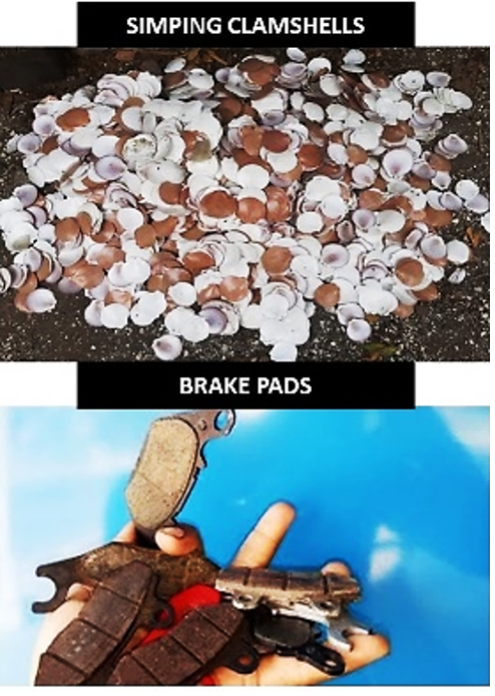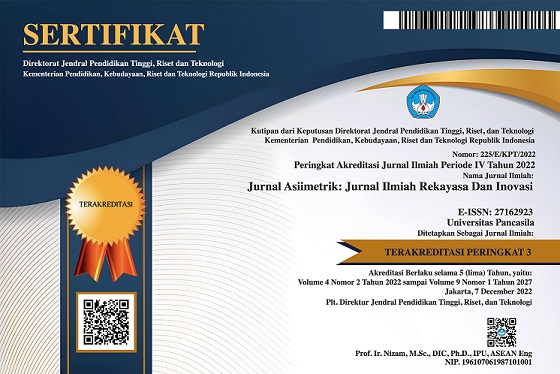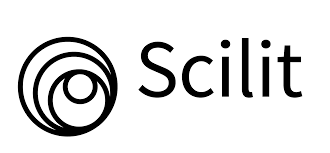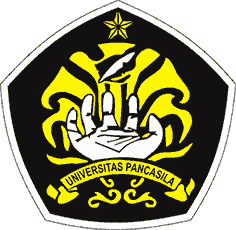The Influence of Simping Clamshell Addition on Disc Brake Pad Mechanical Properties
Pengaruh Penambahan Kulit Kerang Simping terhadap Sifat Mekanik pada Kampas Rem Cakram
DOI:
https://doi.org/10.35814/asiimetrik.v5i2.4984Keywords:
brake pads, simping clamshell, mechanical propertiesAbstract
The brake pads made from asbestos are environmentally hazardous due to the friction and abrasion occurring during braking, resulting in the release of airborne asbestos fibers. These fibers pose various health risks to humans and contribute to environmental pollution. This study aims to analyze the influence of adding clamshell waste material on the mechanical properties of motorcycle disc brake pads. The research utilized an experimental approach, conducting tensile and friction tests on six samples with different compositions: 100% brake pads, 40% brake pads, 60% simping clamshell, 60% brake pads, 40% simping clamshell, 20% brake pads, 80% simping clamshell, 50% brake pads, 50% simping clamshell, and 100% brake pads. The results indicate that the sample comprising 50% used brake pads and 50% simping clamshell exhibited the smallest difference in thickness, measuring 0.05 mm or 0.59%, indicating the strongest adhesive strength and wear resistance compared to other variations. Thus, a higher simping clamshell composition sacrifices some tensile strength but offers improved elasticity, benefiting specific braking conditions.
Downloads
References
Arif, S., Irawan, D. and Jainudin, M. (2019) ‘Karakteristik Sifat Mekanis Disk Pad Komposit Serbuk Kayu Jati – Polyester’, in Prosiding SENTRA (Seminar Teknologi dan Rekayasa). Seminar Teknologi dan Rekayasa (SENTRA), Malang: Fakultas Teknik Universitas Muhammadiyah Malang, pp. 1–8.
Borawski, A. (2019) ‘Common Methods in Analysing the Tribological Properties of Brake Pads and Discs – A Review’, Acta Mechanica et Automatica, 13(3), pp. 189–199.
Dwiyati, S.T., Kholil, A. and Widyarma, F. (2017) ‘Pengaruh Penambahan Karbon Pada Karakteristik Kampas Rem Komposit Serbuk Kayu’, Jurnal Konversi Energi dan Manufaktur, 4(2), pp. 108–114.
Elzayady, N. and Elsoeudy, R. (2021) ‘Microstructure and wear mechanisms investigation on the brake pad’, Journal of Materials Research and Technology, 11, pp. 2314–2335.
Hanifah, H., Sutedja, A. and Ahmaddien, I. (2020) Pengantar Statistika. Bandung: CV. WIDINA MEDIA UTAMA [Print].
Ihsan, M.N., Wicaksono, D. and Sehono, S. (2022) ‘Uji Keausan Kampas Rem Berbahan Limbah Organik Menggunakan Metode Ogoshi’, Teknika STTKD: Jurnal Teknik, Elektronik, Engine, 8(1), pp. 92–96.
Ishak, M.R. et al. (2016) ‘Brake torque analysis of fully mechanical parking brake system: Theoretical and experimental approach’, Measurement, 94, pp. 487–497.
Jadhav, S.P. and Sawant, S.H. (2019) ‘A review paper: Development of novel friction material for vehicle brake pad application to minimize environmental and health issues’, in Materials Today: Proceedings. 1st International Conference on Manufacturing, Material Science and Engineering, India: Elsevier, pp. 209–212.
Mulani, S.M. et al. (2022) ‘A review on recent development and challenges in automotive brake pad-disc system’, in Materials Today: Proceedings. International Conference on Materials, Machines and Information Technology-2022, India: Elsevier, pp. 447–454.
Neis, P.D. et al. (2017) ‘Towards a better understanding of the structures existing on the surface of brake pads’, Tribology International, 105, pp. 135–147.
Phillips, C., Kortschot, M. and Azhari, F. (2022) ‘Towards standardizing the preparation of test specimens made with material extrusion: Review of current techniques for tensile testing’, Additive Manufacturing, 58, p. 103050.
Prabowo, H.T. et al. (2017) ‘Sifat Mekanik Bahan Komposit Kampas Rem Berbahan Dasar Serbuk Arang Kulit Buah Mahoni’, Spektra: Jurnal Fisika dan Aplikasinya, 2(2), pp. 127–132.
Pujari, S. and Srikiran, S. (2019) ‘Experimental investigations on wear properties of Palm kernel reinforced composites for brake pad applications’, Defence Technology, 15(3), pp. 295–299.
Sethupathi, P.B., Chandradass, J. and Saibalaji, M.A. (2021) ‘Comparative study of disc brake pads sold in Indian market — Impact on safety and environmental aspects’, Environmental Technology & Innovation, 21, p. 101245.
Singaravelu, D.L. et al. (2019) ‘Development and Performance Evaluation of Eco-Friendly Crab Shell Powder Based Brake Pads for Automotive Applications’, International Journal of Automotive and Mechanical Engineering, 16(2), pp. 6502–6523.
Sinha, A. et al. (2020) ‘Experimental Characterization Protocols for Wear Products from Disc Brake Materials’, Atmosphere, 11(10), pp. 1–23.
Sudarisman, S., Jati, S. and Kamiel, B.P. (2018) ‘Pemanfaatan Limbah Gergajian Kayu Sebagai Bahan Pengisi Material Gesek Rem Cakram’, in Prosiding University Research Colloquium. The 8th University Research Colloquium 2018: Bidang Teknik dan Rekayasa & Bidang Teknik Kebencanaan, Purwokerto: Lembaga Penelitian dan Pengabdian pada Masyarakat Universitas Muhammadiyah Purwokerto, pp. 75–82.
Ta, H. (2023) HT-2402 Computer Servo Control Material Testing Machines, HUNG TA INSTRUMENT (THAILAND) CO.,LTD.
Yudiono, H. and Fuad, M.T.N. (2023) ‘The effect of Aegle marmelos shell particles volume fraction on hardness, toughness, and wear rate of epoxy matrix composites as motorcycle brake pads’, Journal of Mechanical Engineering and Sciences, 17(1), pp. 9338–9348.





























